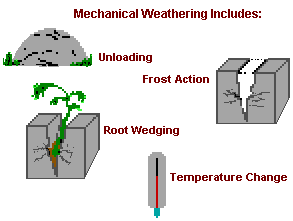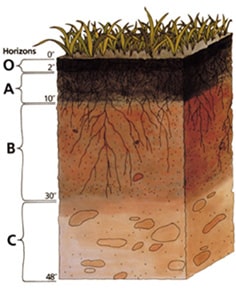After rocks are formed, they are weathered when exposed at the surface; this prepares material for transport by erosional processes in the rock cycle two main types of weathering include mechanical (disintegration) and chemical (decomposition) that act together and enhance the effectiveness of each other
Mechanical: reduction of rocks to smaller pieces, includes:
 Frost wedging by ice forming in cracks in rocks, breaking them apart; unloading due to expansion on removal of overlying material; biologic activity – roots open fractures
Frost wedging by ice forming in cracks in rocks, breaking them apart; unloading due to expansion on removal of overlying material; biologic activity – roots open fractures
Chemical: dissolution – water in the weathering zone is weak carbonic acid that reacts with most minerals, turns them into substances stable at surface conditions;
Oxidation – dark silicates react with oxygen to form rusty Fe, Mg oxides and clay minerals; hydrolysis – orthoclase in granite switches K+ for tiny H+ ions, turns to clay
Rates of Weathering: depend on how fractured rock is, types of minerals, climate
Rock characteristics: e.g. granite is made of relatively stable minerals and does not weather easily whereas marble (soluble) and dark silicate minerals weather easily; silicate weathering related to Bowen’s reaction series – dark minerals form under high pressure, temperature conditions but stable light ones, under low P and T
Climate: weathering is faster, more intense in warm, wet climates; slow in polar areas
Soil: results from weathering plus biologic activity; soil type depends on five factors:
Parent material: type of bedrock, sediment determines rate of soil formation, fertility
Time: more time, greater intensity and depth of soil development on a parent material
Climate: most important; soil forms fast & deep in tropics, slow & shallow near poles
Plants, animals: decompose to humus, release nutrients, hold soil moisture, aerate
Topography: steep slopes erode easily – do not hold moisture or vegetation well
Soil profile: develops downward from the ground surface as layered horizons:
- O decomposed humus (like compost)
- A mixture of mineral matter and humus
- E eluviated (downward-transported) fines and leaching of ions in solution
- B accumulation of oxides and clays (in wet climates)
- C weathered parent material (regolith) parent material
Soil Erosion: serious problem worldwide; we need soils for food production
Starts with raindrops displacing soil particles then sheet erosion washes them into rills, gullies, and eventually to streams that carry the soil away; accelerated by deforestation by farming, logging, construction etc – plants anchor, protect topsoil soil erosion also clogs reservoirs, streams, reducing holding capacity, flood control


wow so exciting…..